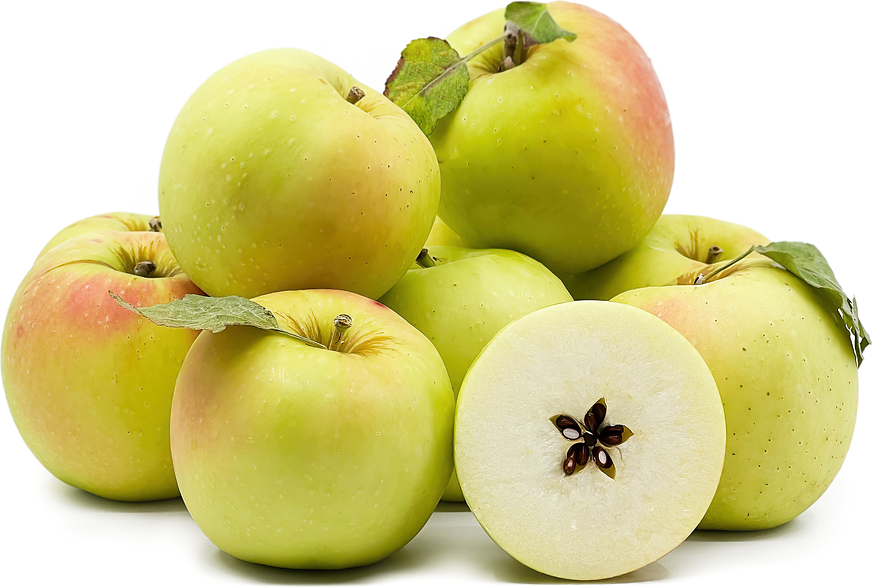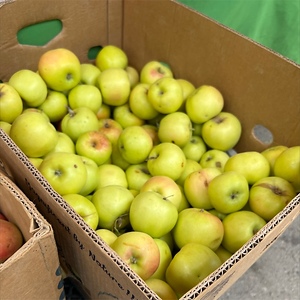


Ozark Gold Apples
Estimated Inventory, lb : 0
Description/Taste
Ozark Gold apples are somewhat uniform with a round to cylindrical shape, connected to a slender and fibrous, dark brown stem. The skin is smooth, waxy, tough, and firm, ripening from pale green to golden yellow when mature. The skin may also bear prominent lenticels and light pink to red patches of blush where it was most exposed to the sun. Underneath the surface, the flesh is moderately crisp, fine-grained, aqueous, and white to cream-colored, encasing a small core filled with oval, dark brown-black seeds. Ozark Gold apples are aromatic and have a sweet, subtly tart flavor with mild acidity. The taste is initially reminiscent of honey and vanilla, transitioning into notes of pear and marzipan.
Seasons/Availability
Ozark Gold apples are harvested in the late summer and can be stored through the early spring.
Current Facts
Ozark Gold apples, botanically classified as Malus domestica, are a late summer variety that belongs to the Rosaceae family. Also known as Ozark apples and Oz Gold apples, Ozark Gold apples were developed in the United States in the 20th century as an improved, faster-maturing variety of golden delicious apples. Though the cultivar was initially grown and intended for warm, southern climates, the apples displayed optimum growth characteristics when cultivated in cooler climates and became a variety that struggled to find widespread success. In the present day, Ozark Gold apples are not commercially cultivated in the United States and are primarily found through local farmer’s markets. Despite their lack of commercial availability in the United States, the variety has seen some success in cultivation through farms in Russia, Eastern Europe, and Central Asia.
Nutritional Value
Ozark Gold apples are an excellent source of fiber, which can help promote digestion, and are a good source of vitamins C and B6, which can help boost the immune system and reduce fatigue in the body. The apples also contain some potassium, magnesium, copper, and phytochemicals such as flavonoids.
Applications
Ozark Gold apples are best suited for both raw and cooked applications such as baking and boiling. The moderately crisp but tender flesh is showcased when consumed fresh, out-of-hand, chopped and mixed into fruit bowls, tossed into salads, or sliced and displayed on appetizer plates. The apples can also be blended into sauces, juiced into drinks, cooked into soups, or baked into pies, scones, muffins, and tarts. Ozark Gold apples pair well with vanilla, cinnamon, celery, grapes, cheeses such as gruyere, blue, camembert, sharp cheddar, and brie, and meats such as pork and poultry. The fresh apples will keep 2-3 months when stored whole and unwashed in the crisper drawer of the refrigerator. It is also believed the flavor of Ozark Gold apples will improve with storage.
Ethnic/Cultural Info
The Missouri State Fruit Experiment Station was established in 1899 as a solution to the statewide disease and insect problem that was plaguing fruit farmers in Missouri. In an effort to study the significant pests and increase cultivation, the station began creating breeds with improved characteristics such as the Ozark Gold in the 20th century. With its release, Ozark Gold apples did not see immediate success and struggled to gain commercial attention in the United States. Despite the lack of notoriety in the United States, the variety was discovered to respond favorably to colder climates and became a cultivated variety in Russia. During the collapse of the USSR, many people were forced to change careers in order to survive. One example of this career shift can be seen through the vendor who sold the Ozark Gold apples featured in the photograph above. The vendor was once a construction worker who began cultivating apples after the collapse of the USSR. In the present day, he is considered to be one of the leading experts in apple cultivation in Talgar, which is a town in the Almaty region of Kazakhstan.
Geography/History
Ozark Gold apples were developed in 1970 at the Missouri State Fruit Experiment Station in Mountain Grove, Missouri. The variety was created from crossings of the golden delicious, red delicious, jonathan, and ben davis apple and was bred with the intention of developing a late-summer variety with quality flavor and improved resistance to disease. Today Ozark Gold apples are still cultivated in select regions of the Ozarks in Missouri, but the variety has seen greater success in areas of the Appalachian Mountains and the southern Midwest. Ozark Gold apples are not commercially cultivated and are available through local farm stands and online seed catalogs for home gardening. Outside of the United States, the variety is grown in Eastern Europe, Russia, and Central Asia and has seen success in regions with colder climates. The apples in the photo above were found at a weekend food fair in Almaty, Kazakhstan.








